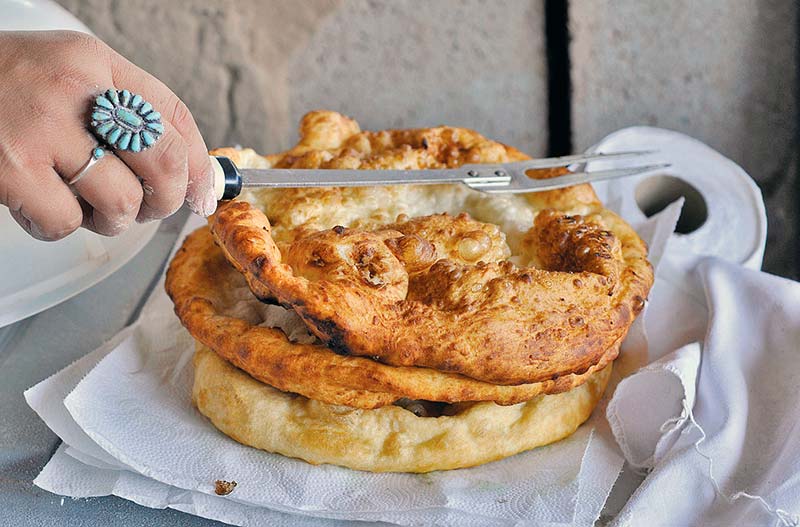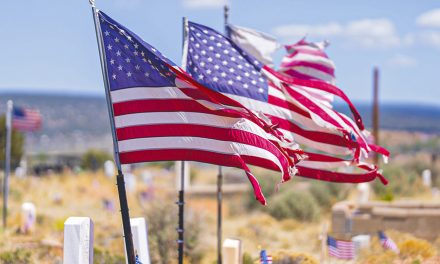
50 Years Ago: A part of Diné culture: Frybread

Navajo Times | Donovan Quintero A Miss Navajo contestant grabs her fork from the top of a pile of fry bread in this file photo during the Miss Navajo fry bread competition in Window Rock last year.
As members of the Navajo Nation celebrated the centennial of the Long Walk 50 years ago, it was also time to take note of another milestone in the cultural history of the Navajo people – the frybread.
One of the results of the captivity of the Navajos at Fort Sumner was the beginning of the Native American arts and crafts market as soldiers sought out Navajo weavers for blankets and rugs with that unique Navajo design.
The need was created out of necessity. As the story goes, the main diet for Navajos at the time was vegetables and beans, something that was in short supply at Fort Sumner.
So, in order to make sure that the Navajo captives had enough to eat, the U.S. Army provided the families with canned goods as well as a good supply of white flour, processed sugar and lard.
The Navajos in turn used the flour, sugar and lard to make what they named “frybread” which quickly became a favored commodity not only for the Navajos but also for the soldiers who were responsible for guarding them.
The celebration held by the tribe in the summer of 1968 attracted a lot of national attention as big city newspapers as well as a number of travel and other magazines did features on frybread and its affects on the Navajo population over the next century.
The power of frybread spread through Indian Country and a number of tribes picked it up and adapted to their own culture to the point where the writer Sherman Alexie used it as a metaphor for the power and majesty of the Indian people in his award-winning film “Smoke Signals” when he had one of the characters in the movie wear a T-shirt with the slogan “Frybread Power” on it.
It was probably the food of choice for many that summer who took part in the re-enactment of the Long Walk. But the mainstay of the Navajo diet came under fire by none other than the Navajo Times.
This was during a time when the paper had converted to a tabloid approach to the news with the paper focusing its attention in one major subject a week. One of those subjects centered on traditional foods of the Navajo and how this, combined with the young Navajos growing more and more dependent on sugary sweets, was creating what the Times would call a crisis on the reservation because of the growing number of tribal members being diagnosed with diabetes.
Back some 50 years ago, no one wrote about diabetes but Indian Health Service officials were beginning to see the first cases of the disease in the younger population. The average piece of frybread had between 700 and 750 calories and contained as much as 25 grams of fat.
In news from that week, the Navajo Times reported the death of another Navajo soldier in the Vietnam War. Pvt. Michael H. Bia was only 24 when he was killed on June 6, 1968, while he serving as a paratrooper for the 101st Airborne Brigade. A graduate of St. Michael High School, Bia had joined up the previous September. In the front-page article, the Navajo Times also took note of his membership in the All Indian Rodeo Cowboys Association and the fact that he came in fifth in the bull-riding competition in 1967.
By this time in 1968, almost every program and department in the tribal government was putting the finishing touches on their roles in the upcoming 100th anniversary of the signing of the Treaty of 1868. The tribe announced this week that the month of a July would include numerous events to showcase the tribe’s recognition of the event.
Navajo Tribal Chairman Raymond Nakai had already said that the tribe would spare no expense in recognizing the event. He said he wanted the events to be remembered for decades. On July 2 and 3, Nakai was planning a reenactment of the treaty signing at the Window Rock Civic Center complete with participants wearing authentic traditional garb and non-Navajos wearing U.S. Army and scouts’ clothing.
Three days before that, the tribe had made arrangements for a reenactment of the Long Walk. “One hundred and fifty Navajos, 25 horses, three wagons and three U.S. cavalrymen would take part in the 1968 version of the Long Walk,” the Navajo Times reported. Meanwhile the events taking place that week at the Window Rock fairgrounds included western dances, rodeos and vendors selling food and jewelry.
There were competitions galore. These include frybread competitions, a beard-growing competition and a watermelon bust. Little League teams will also be hosting their own contests. July 4 had been named Barboncito Day, followed by Ganado Mucho Day, which would be followed by Manuelito Day.
The week would end with a Saturday parade on what the tribe was calling Nakai Day. The Navajo Times planned to get involved by publishing a special Centennial Days edition along with its regular edition.
The paper promised it would be the biggest issue ever printed by the paper with scores of articles on Navajo history and culture by Navajo and non-Navajo writers. It was also expected to contain a record number of advertisements.
The paper was charging higher rates to advertise in the special issue since it would be out throughout the summer. The paper had ordered 26,000 copies of the paper, more than six times its normal run.
Almost every business on the reservation and in the border communities that catered to Navajos had agreed to advertise and as the number of advertisers increased, the paper was growing in size to be 40 pages or more.
Dick Hardwick, the paper’s publisher, had been working on the issue since January and had been begging for area writers to get involved by writing something. He had also asked department employees to write stories as well even though he knew most of those would be dry essays.
But even with this, he said later that he was scrambling almost up to deadline day to find enough material to fill up all of the editorial space. The issue itself would be noteworthy because of its size and the number of people who were credited with writing articles. A lot of Navajo families kept their issues for decades, bringing them out to show friends.
To read the full article, pick up your copy of the Navajo Times at your nearest newsstand Thursday mornings!
Are you a digital subscriber? Read the most recent three weeks of stories by logging in to your online account.








 Highway 264,
Highway 264, I-40, WB @ Winslow
I-40, WB @ Winslow